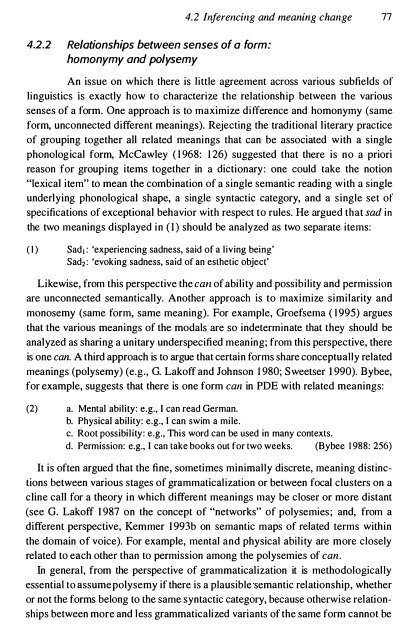Gram - SEAS
Gram - SEAS
Gram - SEAS
Create successful ePaper yourself
Turn your PDF publications into a flip-book with our unique Google optimized e-Paper software.
4.2.2 Relationships between senses of a form:<br />
homonymy and polysemy<br />
4.2 Illjerellcillg and meaning change 77<br />
An issue on which there is little agreement across various subfields of<br />
linguistics is exactly how to characterize the relationship between the various<br />
senses of a form. One approach is to maximize ditl"erence and homonymy (same<br />
form, unconnected different meanings). Rejecting the traditional literary practice<br />
of grouping together all related meanings that can be associated with a single<br />
phonological form, McCawley (1968: 126) suggested that there is no a priori<br />
reason for grouping items together in a dictionary: one could take the notion<br />
"lexical item" to mean the combination of a single semantic reading with a single<br />
underlying phonological shape, a single syntactic category, and a single set of<br />
specifications of exceptional behavior with respect to rules. He argued that sad i n<br />
the two meanings displayed in (I) should be analyzed as two separate items:<br />
(I) Sad,: 'experiencing sadness, said of a living being'<br />
Sad2: 'evoking sadness, said of an esthetic object'<br />
Likewise, from this perspective the call of ability and possibility and permission<br />
are unconnected semantically. Another approach is to maximize similarity and<br />
monosemy (same form, same meaning). For example, Groefsema (1995) argues<br />
that the various meanings of the modals are so indeterminate that they should be<br />
analyzed as sharing a unitary underspecified meaning; from this perspective, there<br />
is one can. A third approach is to argue that certain forms share conceptually related<br />
meanings (polysemy) (e.g., G. Lakoff and Johnson 1980; Sweetser 1990). Bybee,<br />
for example, suggests that there is one form can in PDE with related meanings:<br />
(2) a. Mental ability: e.g., I can read German.<br />
b. Physical ability: e.g., I can swim a mile.<br />
c. Root possibility: e.g., This word can be used in many contexts.<br />
d. Permission: e.g., I can take books out for two weeks. (Bybee 1988: 256)<br />
It is often argued that the fine, sometimes minimally discrete, meaning distinctions<br />
between various stages of grammaticalization or between focal clusters on a<br />
cline call for a theory in which different meanings may be closer or more distant<br />
(see G. Lakoff 1987 on the concept of "networks" of polysemies; and, from a<br />
different perspective, Kemmer 1993b on semantic maps of related terms within<br />
the domain of voice). For example, mental and physical ability are more closely<br />
related to each other than to permission among the polysemies of can.<br />
In general, from the perspective of grammaticalization it is methodologically<br />
essential to assume polysemy if there is a plausible semantic relationship, whether<br />
or not the forms belong to the same syntactic category, because otherwise relationships<br />
between more and less grammaticalized variants of the same form cannot be
















